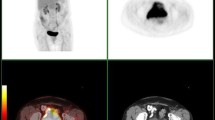Abstract
Purpose
Compared with computed tomography (CT) and magnetic resonance imaging (MRI), positron emission tomography (PET) may have additional value in the assessment of primary and recurrent cervical cancer. However, the degree of tumour uptake of 18F-2-fluoro-2-deoxy-d-glucose (FDG) uptake is sometimes influenced by diabetes mellitus (DM). Therefore, we conducted this prospective study to compare the diagnostic ability of FDG-PET in patients with cervical cancer complicated by DM and those without DM.
Methods
Patients with untreated locally advanced primary or clinically curable recurrent cervical carcinoma were enrolled. Both FDG-PET and MRI/CT scans were performed within 2 weeks. Patients were categorised into the following groups: hyperglycaemic DM (fasting blood sugar >126 mg/dl), euglycaemic DM and non-DM. The lesions were confirmed histologically or by clinical follow-up. The receiver operating characteristic curve method, with calculation of the area under the curve (AUC), was used to evaluate the discriminative power.
Results
From February 2001 to January 2003, 219 patients (75 with primary and 144 with recurrent cervical cancer) were eligible for analysis. Sixteen had hyperglycaemic DM, 12 had euglycaemic DM and 191 were in the non-DM group. The diagnostic power of PET in the hyperglycaemic DM, euglycaemic DM and non-DM groups did not differ significantly with regard to the identification of either metastatic lesions (AUC, 0.967/0.947/0.925, P>0.05) or primary tumours/local recurrence (AUC, 0.950/0.938/0.979, P>0.05). Considering all DM patients, PET showed a significantly higher detection power than MRI/CT scans in respect of metastatic lesions (AUC=0.956 vs 0.824, P=0.012).
Conclusion
In comparison with its accuracy in non-DM patients, the accuracy of PET in cervical cancer patients with mild to moderate DM was not significantly reduced.
Similar content being viewed by others
References
Department of Health, the Executive Yuan. Cancer registry annual report in Taiwan area, Department of Health, Executive Yuan, ROC, 2003.
Yen TC, Ng KK, Ma SY, Chou HH, Tsai CS, Hsueh S, et al. Value of dual-phase 2-fluoro-2-deoxy-D-glucose positron emission tomography in cervical cancer. J Clin Oncol 2003;21:3651–8.
Tsai CC, Tsai CS, Ng KK, Lai CH, Hsueh S, Kao PF, et al. The impact of image fusion in resolving discrepant findings between FDG-PET and MRI/CT in patients with gynaecological cancers. Eur J Nucl Med Mol Imaging 2003;30:1674–83.
Ma SY, See LC, Lai CH, Chou HH, Tsai CS, Ng KK, et al. Delayed [18F]-2-fluoro-2-deoxy-glucose positron emission tomography for detection of para-aortic lymph node metastases in cervical cancer patients. J Nucl Med 2003;44:1775–83.
Yen TC, See LC, Lai CH, Yah-Huei CW, Ng KK, Ma SY, et al. [18F]-2-fluoro-2-deoxy-D-glucose uptake in squamous cell carcinoma of the cervix is correlated with glucose transporter 1 expression. J Nucl Med 2004;45:22–9.
Lai CH, Huang KG, See LC, Yen TC, Tsai CS, Chang TC, et al. Restaging of recurrent cervical cancer with dual-phase positron emission tomography. Cancer 2004;100:544–52.
Tsai CS, Chang TC, Lai CH, Tsai CC, Ng KK, Hsueh S, et al. A preliminary report of using FDG-PET to detect extrapelvic lesions in cervical cancer patients with enlarged pelvic lymph nodes shown on MRI/CT images. Int J Radiat Oncol Biol Phys 2004;58:1506–12.
Diederichs CG, Staib L, Glatting G, Beger HG, Reske SN. FDG PET: elevated plasma glucose reduces both uptake and detection rate of pancreatic malignancies. J Nucl Med 1998;39:1030–3.
Zimny M, Bares R, Fass J, Adam G, Cremerius U, Dohmen B, et al. Fluorine-18 fluorodeoxyglucose positron emission tomography in the differential diagnosis of pancreatic carcinoma: a report of 106 cases. Eur J Nucl Med 1997;24:678–82.
Dave NN, Walia R, Shor M, Ali A. Effect of hyperglycemia on tumoral uptake of F-18 FDG. Clin Nucl Med 2002;27:682–3.
Crippa F, Gavazzi C, Bozzetti F, Chiesa C, Pascali C, Bogni A, et al. The influence of blood glucose levels on [18F]fluorodeoxyglucose (FDG) uptake in cancer: a PET study in liver metastases from colorectal carcinoma. Tumori 1997;83:748–52.
Kubota K, Kubota R, Yamada S, Tada M, Takahashi T, Iwata R. Re-evaluation of myocardial FDG uptake in hyperglycemia. J Nucl Med 1996;37:1713–7.
Peters AL, Schriger DL. The new diagnostic criteria for diabetes: the impact on management of diabetes and macrovascular risk factors. Am J Med 1998;105:15S–9S.
Unwin N, Shaw J, Zimmet P, Alberti KGMM. Impaired glucose tolerance and impaired fasting glycemia: the current status, definition and intervention. Diabet Med 2002;19:708–23.
Anzai Y, Carroll WR, Quint DJ, Bradford CR, Minoshima S, Wolf GT, et al. Recurrence of head and neck cancer after surgery or irradiation: prospective comparison of 2-deoxy-2-(F-18)fluoro-D-glucose PET and MR imaging diagnosis. Radiology 1996;200:135–41.
Hanley JA, McNeil BJ. A method of comparing the areas under a receiver operating characteristic curves derived from the same cases. Radiology 1983;148:839–43.
Lindholm P, Minn H, Leskinen-Kallio S, Bergman J, Ruotsalainen U, Joensuu H. Influence of the blood glucose concentration on FDG uptake in cancer: a PET study. J Nucl Med 1993;34:1–6.
Gorenberg M, Hallett WA, O’Doherty MJ. Does diabetes affect [18F]FDG standardized uptake values in lung cancer? Eur J Nucl Med Mol Imaging 2002;29:1324–7.
Zhao S, Kuge Y, Tsukamoto E, Mochizuki T, Kato T, Hikosaka K, et al. Effects of insulin and glucose loading on FDG uptake in experimental malignant tumors and inflammatory lesions. Eur J Nucl Med 2001;28:730–5.
Wahl RL, Henry CA, Ethier SP. Serum glucose: effects on tumor and normal tissue accumulation of 2-[F-18]-fluoro-2-deoxy-D-glucose in rodents with mammary carcinoma. Radiology 1992;183:643–7.
Langen KJ, Braun U, Rota Kops E, Herzog H, Kuwert T, Nebeling B, et al. The influence of plasma glucose levels on fluorine-18-fluorodeoxyglucose uptake in bronchial carcinoma. J Nucl Med 1993;34:355–9.
Torizuka T, Clavo AC, Wahl RL. Effects of hyperglycemia on in vitro tumor uptake of tritiated FDG, thymidine, L-methionine and L-leucine. J Nucl Med 1997;38:382–6.
James DE. Targeting of the insulin-regulatable glucose transporter (GLUT-4). Biochem Soc Trans 1994;22:668–70.
Author information
Authors and Affiliations
Corresponding author
Rights and permissions
About this article
Cite this article
Chang, YC., Yen, TC., Ng, KK. et al. Does diabetes mellitus influence the efficacy of FDG-PET in the diagnosis of cervical cancer?. Eur J Nucl Med Mol Imaging 32, 647–652 (2005). https://doi.org/10.1007/s00259-004-1744-1
Received:
Accepted:
Published:
Issue Date:
DOI: https://doi.org/10.1007/s00259-004-1744-1



